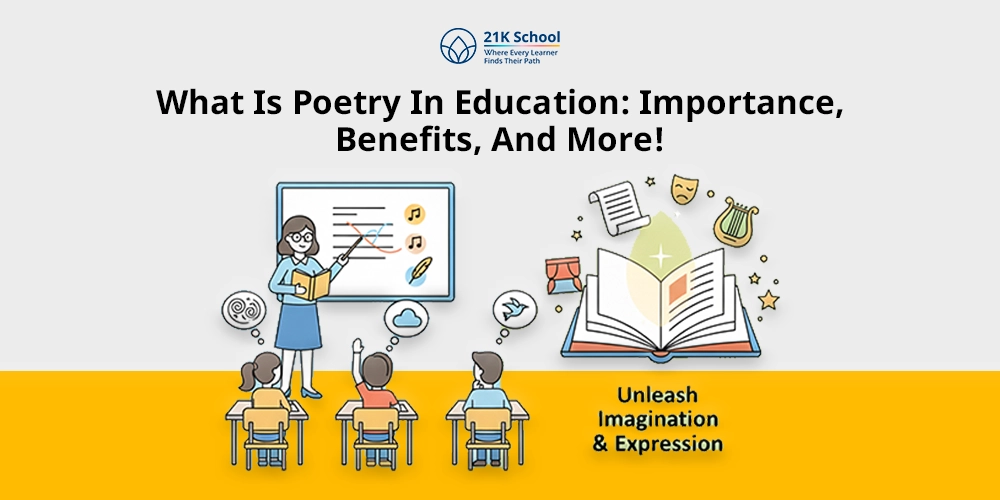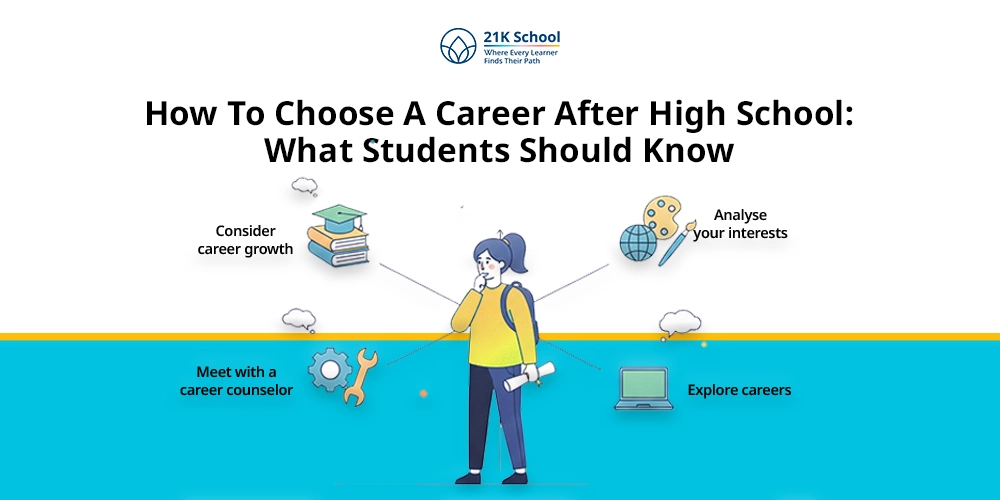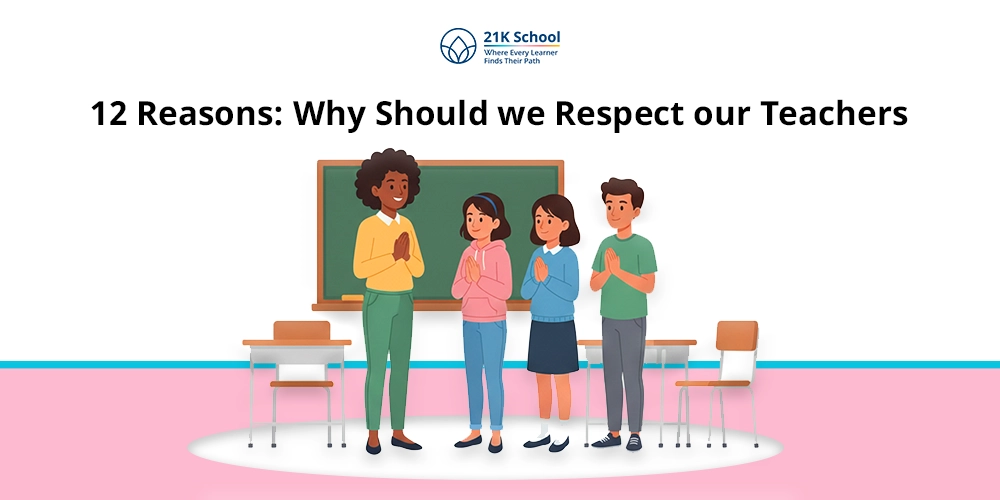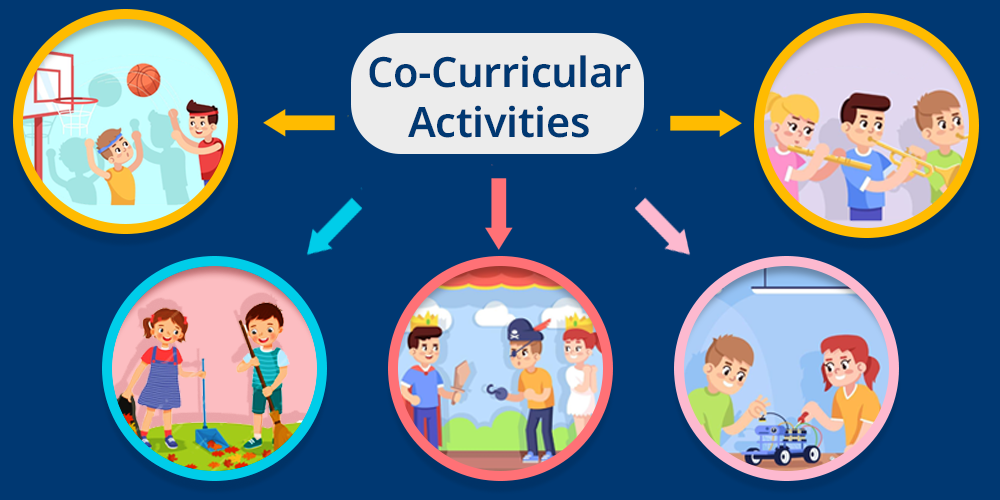
What do co-curricular activities mean to you?
Have you ever been involved in one?
Honestly, co-curricular activities play a dominant and important role in shaping a well-rounded individual’s life journey as they contribute significantly to the holistic development of learners.
Multiple activities fall under the right explanation of co-curricular activity, and these activities complement academic learning and help students acquire all the important skills that help them grow beyond the classroom environment– it’s everything about skill development.
So, what exactly is……
Contents
- What is Co Curricular Activities?
- Importance of Co curricular Activities
- Significance of Co Curricular Activities
- Types of Co-Curricular Activities
- Principles of Co Curricular Activities
- Co-Curricular Activities Examples in School
- Co-Curricular vs. Extracurricular Activities
- Role of Teacher and Student in Co curricular Activities
- Benefits of Co-Curricular Activities
- 1. Personal Development and Growth
- 2. Advanced Academic Results
- 3. Self-esteem and Confidence
- 4. Teamwork and Social Skills
- 5. Mental Health and Physical Health
- 6. Favorable Behavior and Involvement
- 7. New Experiences Exposure
- 8. Community Engagement
- 9. Intellectual and Educational advantages
- 10. Emotional, Social Development
- 11. Career and Skill Development
- Challenges in Co-Curricular Participation and Solutions
- Conclusion
What is Co Curricular Activities?
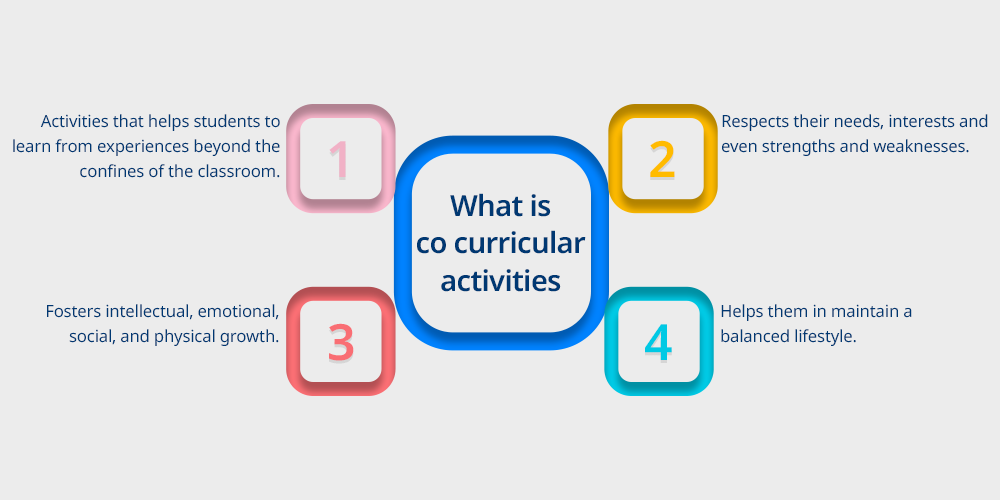
These activities help a student to learn from experiences beyond the confines of the classroom.
It supports growth in almost every aspect of life by fostering intellectual, emotional, social, and physical growth, preparing them well for the future — real-life learning with real involvement.
These activities cater to the diverse needs of the learners, respecting their needs, interests, and even strengths and weaknesses.
It provides them a well-needed opportunity to explore their passion and build all essential life skills – which ultimately helps them maintain a balanced lifestyle.
There are multiple benefits to co-curricular activities . But at the same time, there are many types of activities that cater to the needs and interests of learners, so let’s first know about the types of activities that go beyond the classroom experiences.
Importance of Co curricular Activities
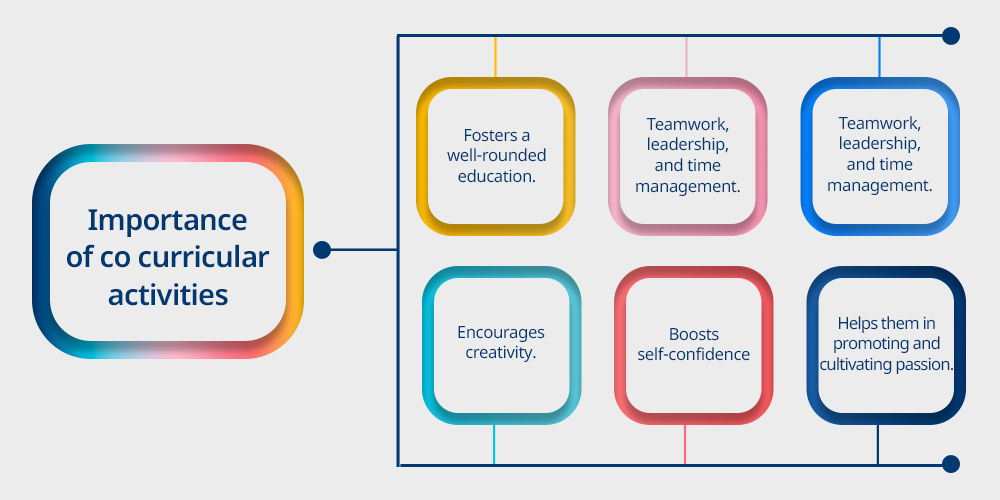
Co-curricular activities are very essential for students, it’s like giving them a life beyond their usual classroom environment. A situational place that fosters a well-rounded education.
As these go beyond the classroom, they help students experience and learn skills like: teamwork, leadership, and time management.
These activities boost a learner’s physical, mental, emotional, and overall well-being. It also encourages creativity and boosts self-confidence in the same. Let’s discuss its importance in detail.
1. Offers a Relief from Classroom Education
- Gives students a life that is not centered on textbooks and exams.
- Provides an ambience in situations that facilitates overall growth.
2. Increases Life Skills
- Instills important values of teamwork, leadership, time management and responsibility.
- Equips the students with confidence to encounter real life situations.
3. Supports Total Well Being
- Enhances body health by engaging in sporting activities.
- Accommodates psychological and emotional development by limiting stress and making improvements to mood.
4. Facilitates the Imagination and Self-Expression
- Presents the student with an opportunity to pursue artistic abilities in music, drama, or art.
- Develops self- confidence- the performances and competitions are held publicly.
5. Offers Hands on Experience
- Assists pupils in linking the knowledge learnt in classrooms to real life situations.
- Promotes problem solving, critical thinking and innovation.
6. Accommodates a Moderate Life Style
- Encourages individual interests and hobbies as well as academics.
- Promotes healthy work-life balance at a young age.
Significance of Co Curricular Activities
The major significance of co-curricular activity is that it nurtures the ability of holistic development.
When experienced, it helps bridge the gap between theoretical knowledge and real-world application.
Co-curricular activities enhance social skills, build resilience, and even promote a sense of community and responsibility.
It helps in shaping individuals and makes learners not just ace the academic aspect rather also makes them proficient emotionally and socially.
Types of Co-Curricular Activities
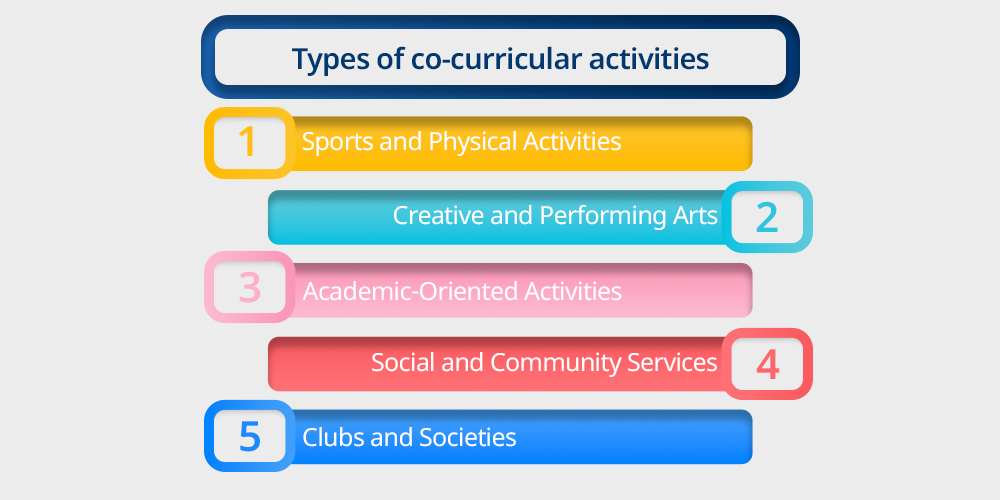
| Category | Examples | Benefits |
| Sports and Physical Activities | Football, Athletics, Yoga | Sports and Physical Activities promote physical fitness, instill discipline, teach teamwork, enhance stamina, and build resilience. |
| Creative and Performing Arts | Dance, Music, Drama | These performing arts and creative co-curricular activities foster self-expression, build confidence, improve public speaking, overcome stage fear, and nurture emotional intelligence. |
| Academic-Oriented Activities | Debates, Quizzes, Science Fairs | Academic-oriented activities like debates, quizzes, etc. enhance critical thinking, encourage in-depth learning, boost research and analytical skills, and foster a thirst for lifelong learning. One of the most famous examples of this is: Model United Nations |
| Social and Community Services | Volunteering, Cleanliness Drives | Social and Community Services instill empathy, develop civic responsibility, encourage leadership, teamwork, and awareness of social issues, among learners. These activities make them better and more responsible individuals in the society. |
| Clubs and Societies | Literary Clubs, Tech Clubs, Eco-Clubs | Clubs and Societies promote specialized skills, collaboration, networking, problem-solving, and project management while promoting shared interests — a very similar approach to collaborative learning but for skills, interest, passion and not just focusing academically. |
1. Sport and Physical Activities
Sport and physical activities pay attention to the physical development of students and their general well-being. They assist in developing strength, stamina, discipline, team work and leadership.
Examples include:
- Volleyball, basketball, football
- Track and field sports
- Yoga and martial arts
- Fitness in schools or inter-school sports events.
Benefits:
- Supports physical well being
- Teambuilding and sportsmanship
- Incorporates time management skills and ability to bounce back in adverse situations
2. Creative and Performing Arts
Creative and performing arts activities assist students in creativity and confidence by enabling them to express themselves artistically and emotionally.
Examples include:
- Performance dance, drama, and music
- Sculpture, drawing, painting
- Talent shows or school concerts
- Photography and film making clubs
Benefits:
- Develops a taste for aesthetics and added imagination
- Enhances self expression and communication
- Stimulates culture and emotional growth
3. Academic-Oriented Activities
Academic-Oriented activities support academic studies by applied practice and intellectual pursuits beyond the schoolroom.
Examples include:
- Quiz contests and debates
- Science exhibitions and fairs
- Clubs for maths genius and coding
- Essay contest or spelling bees
Benefits:
- Enhances Problem solving and critical thinking
- Fosters curiosity of the mind
- Develops subject related skills in an enjoyable and interesting manner
4. Community Services
Through community services, students are able to learn and embrace social responsibility, empathy and civic values.
Examples include:
- Cleanliness drives/ planting trees
- Helping out at NGOs/ old-age homes.
- Awareness drives on blood donation
- Charity fundraising
Benefits:
- Teaches compassion and leadership qualities
- Promotes responsibility as a citizen
- Teaches the importance of contributing back to society
5. Clubs and Societies
Through clubs and societies, the students get to learn and exploit more of their interest and talents in particular fields.
Examples include:
- Literary society, eco club or science club
- Robotics clubs or astronomy clubs
- Leadership programs and student council
- Cultural and language clubs
Benefits:
- Encourages team work and self initiative
- Develops leadership and organization capability
- Brightens identity and social skills
As discussed under the types of co-curricular activities there are a lot of benefits to the same, which helps every student become a better version of themselves and teaches some of the most important life skills.
So, as we go ahead we will now discuss the benefits and drawbacks of being involved in co-curricular activities.
Principles of Co Curricular Activities
Co-curricular activities are important in the overall student development, as it supplements the academic work. With the help of educational value, student-centeredness, inclusiveness, and skill-building, comes as the guiding principles.
These activities encourage creativity, leadership, teamwork, and self-confidence. This requires proper planning, balance, and frequent involvement to be meaningful and self-growing.
1. Holistic Development
Before getting into the conversation it is important to understand,
What is holistic development?
It is a development that caters to the overall growth of students, and co-curricular activities address- their intellectual, physical, emotional, and social needs along with their academic learning.
2. Inclusivity and Diversity
Co-curricular activities are specifically designed to teach and nurture talents based on their interests and passions.
It promotes equal opportunities for learners, across all platforms to explore potential regardless of their belonging and cultural background.
3. Integration with Curriculum
Co-curricular activities should have activities that complement academic learning and provide practical insights into the theoretical knowledge that is taught in the classroom.
This can help in enhancing the educational experience.
4. Voluntary Participation
Honestly, participation in co-curriculum activities should be a voluntary decision. Participation should participate in things that drive students’ interests and passions.
Along with this, it is equally crucial to encourage active and genuine participation rather than a forced mandatory involvement.
5. Skill Development
Co-curricular activities should aim at promoting lifelong skills, and just talk about participation and activities involved.
Skills taught in this could be leadership, teamwork, time management, and problem-solving, preparing students for future challenges.
6. Balanced Approach
Co-curricular activities should have a balance between both academics and co-curricular activities, making sure that students have a balance in those without feeling overwhelmed and excel in both.
Co-Curricular Activities Examples in School
| Category | Examples |
| Sports and Physical Activities | Football, Basketball, Athletics, Cricket, Swimming, Badminton, Yoga, Tennis |
| Creative Arts | Dance, Music (Instrumental and Vocal), Drama/Theater, Painting, Sculpture, Photography, Fashion Design |
| Academic Activities | Debates, Quizzes, Science Fairs, Essay Writing Competitions, Model United Nations (MUN), Spelling Bees |
| Social and Community Services | Volunteering (charity drives), Cleanliness Drives, Tree Plantation, Social Awareness Campaigns |
| Clubs and Societies | Literary Club, Eco Club, Robotics Club, Tech Club, Drama Club, Art and Craft Club, Environmental Club |
| Public Speaking and Leadership | Speech Competitions, Leadership Training Programs, Student Council Activities |
| Cultural Activities | Cultural Fairs, Inter-School Competitions, Traditional Dance and Music Performances, Celebrating Cultural Festivals |
Co-Curricular vs. Extracurricular Activities
The key differences between co-curricular and extracurricular activities are based on their definitions and the purpose they serve for schools, institutions, or even students.
They both have their own merits and challenges but the major difference is that co-curricular activities are usually supported by schools and are mandatory for at least one beyond their classroom education but extracurricular activities are not mandatory and have a lesser frequency of occurrence comparatively.
| Aspect | Co-Curricular Activities | Extracurricular Activities |
| Definition | Activities that complement the formal curriculum, usually school-organized and structured. | Activities that take place outside of the official curriculum, typically voluntary and student-initiated. |
| Examples | – Debate clubs, Science fairs, Music bands, Sports (organized in school) | – Sports teams (external), Drama clubs (outside school), Volunteering |
| Purpose | To reinforce academic learning, develop specific skills related to the school’s educational goals. | To provide broader personal and social development, cultivate interests, and passions. |
| School Involvement | Typically organized and supervised by the school and often integrated with academic programs. | Organized outside of school or by external bodies, with minimal or no involvement from the school. |
| Frequency | Regular and often mandatory for certain classes or age groups. | Occasional or irregular, often depending on personal interest and availability. |
| Impact on Academic Learning | Direct connection to academics; they support, enrich, and extend the learning experience. | Indirect connection to academics; focus on personal growth, social skills, and overall development. |
| Examples in Schools | – Music competitions, Sports tournaments, Drama performances, Debate clubs, Quiz contests | – Playing sports with external clubs, Volunteering in local communities, Private tutoring, After-school dance classes |
Role of Teacher and Student in Co curricular Activities
Role of Teacher in Co-Curricular Activities
1. Facilitator and Guide
Teachers act as- facilitators
In co-curricular activities, they provide students with the necessary resources, guidance, and encouragement required to explore their potential and participate in various co-curricular activities.
2. Mentorship
Teachers serve as — mentors
They offer emotional and academic support to students, as and when required. Also, along with that, they even help students achieve their goals and guide them through the journey of their learning, promoting skill development and support even in non-academic areas.
3. Promoting Inclusivity
Teachers ensure — inclusivity
It is the teachers’ responsibility to ensure that all students, regardless of their academic abilities, are given opportunities to engage in co-curricular activities, teaching them equality and promoting an inclusive environment.
4. Assessment and Feedback
Teachers help in — assessment
Teachers assess students’ performance and provide constructive feedback to them, knowing that it will help them grow and improve, both personally and academically.
5. Motivation
Teachers — motivate students
Now this motivation is not just academic or mental, rather they motivate them to pursue activities outside the classroom that align with their interests and talents, helping them develop confidence and self-discipline, for their desired fields.
Role of Co-Curricular Activities in Students’ Life
1. Holistic Development
The introduction to co-curricular activities helps students learn a wide range of skills that are often ignored or neglected in the traditional education system, such as leadership, creativity, teamwork, and time management — all of this is referred to as holistic development.
2. Emotional and Social Growth
Co-curricular activities promote social and emotional growth, they help students in expressing themselves. They also help in building self-esteem and develop social skills by interacting with peers in diverse settings.
3. Stress Relief
Active participation in non-academic activities helps students to relieve stress and naturally balances their academic workload by providing them with a healthy and competitive environment to foresee their emotions.
4. Academic Enhancement
Though it is not directly related to curriculum, there are some co-curricular activities like, debates and science fairs, that complement academic learning and encourage students to apply their knowledge practically and learn from real-life contexts.
5. Career Readiness
These co-curricular activities help students gain practical knowledge and apply those skills, experience, and knowledge in their life afterward.
Skills like; public speaking, confidence, problem-solving, and leadership are valuable for students from future perspectives.
Benefits of Co-Curricular Activities
Participation in co-curricular activities offers numerous benefits to students and these benefits often extend beyond immediate rewards, they are a blessing or discipline a learner adopts for a lifetime.
1. Personal Development and Growth
Co-curricular activities expose students to a broad scope of skills that facilitates personal growth, including time management, discipline, decision-making.
Such experiences tend to assist students to become self aware and more prepared to encounter life issues.
2. Advanced Academic Results
It has been revealed in the studies that better grades are achieved by those students who are involved in co-curricular activities.
The focus and discipline needed in extracurricular activities can be used to employ better study habits, time management, and organizational skills that all contribute positively in academic performance.
3. Self-esteem and Confidence
Active participation in co-curricular activities is likely to increase students confidence and self-esteem.
Learning in these activities, achieving goals and recognition boosts a feeling of accomplishment and pride to the learners which may be transferred in personal and academic lives.
4. Teamwork and Social Skills
Co-curricular activities initiate a way for students to communicate with others not just in the classroom.
Such social experiences allow students to build their communication, conflict-resolution, and collaboration skills, which are the key to personal and professional success.
The concept of a group at sports, clubs and group projects creates a feeling of community and common objectives.
5. Mental Health and Physical Health
Physical activities, e.g. sports, or sports-related clubs, can be used to enhance mental and physical health. Exercise decreases stress, gives more energy and helps to sleep better.
Mentally, involvement in extracurriculars can lessen isolation anxiety as it helps them to have a wholesome way to relieve stress and dissatisfaction.
6. Favorable Behavior and Involvement
Co-curricular activities usually help students to be much involved in their school life. These types of activities offer order and guidance to promote good conduct, responsibility and accountability.
Having a mix of academic and extracurricular activities will help students remain engaged and motivated most of the time.
7. New Experiences Exposure
The co-curricular activities bring students to the experience outside the classroom (public speaking, creative arts, or volunteering).
These activities expand the scope of perceptions of a student and enable him to realize some new interests and abilities.
8. Community Engagement
Enrolling in various activities like volunteering, charity events, or environmental clubs will give a student a feel of social responsibility and civic consciousness.
Through these experiences the students can learn to integrate into their community and feel a sense of belonging and need to positively contribute to society.
It is also a fostering element in the spirit of empathy, charity, and service to others.
9. Intellectual and Educational advantages
Improves concentration, memory and general academic performance. Provokes imaginative thought and self-problem solving.
Develops morale with setting of goals and healthy competition. Instills time management, organization, discipline to facilitate academic achievements.
10. Emotional, Social Development
Increases emotional strength and gets along with stress. Enhances social ability by working in a team and with peers. builds such traits as empathy, cooperation, and trust.
Enhances self confidence and promotes positive self image.
11. Career and Skill Development
Acquires transferable skills like leadership, decision-making skills and adaptability. Promotes responsibility, self-discipline and endurance.
Assists students in finding out their interests and possible career opportunities. Equips students with real-life issues and the workplace of the future.
Challenges in Co-Curricular Participation and Solutions
There are numerous challenges encountered when participating in co-curricular activities, not very complex situations but some common barriers to it is:
Challenges in Co-Curricular Participation
1. Problems with Time Management
One of the most prevalent issues among the students is balancing between academic workload and co-curricular activities.
There are only so many hours in a day, learners find it hard to dedicate enough time to both studies and extra-curricular activities.
This can easily lead to stress, fatigue and even a decline in academic work in case the time is not wisely managed.
2. Shortage of Resources and Facilities
Most schools and institutions have the challenge of poor resources to facilitate various co-curricular activities. Inadequate funding, lack of trained mentors or coaches and the unavailability of the appropriate infrastructure.
Sports grounds, music rooms or art materials, can vastly reduce the quality and supply of activities available. This is limiting to the student involvement and development in other spheres of interest.
3. Unequal Opportunities
Not every student always has equal access to co-curricular activities. The selection can also be subjective at times and the disadvantaged groups may not be able to cover the cost of participation, resources, and travelling.
These inequalities cause exclusion and discourage students who might, otherwise, have talent and interest in particular fields.
4. Academic Pressure
Most learning environments place too much emphasis on academic progress. Thus considering co-curricular activities as distractive instead of supplementary to education.
Parents and teachers can be discouraging especially during exam periods and this diminishes the essence of acquiring holistic skills out of the classroom.
5. Unawareness/Disinterest
Not all students are aware of the variety of co-curricular choices open to them, or of the long term advantages of involvement.
Others might lack the exposure or the enthusiasm of those around them or peers and hence are not encouraged or motivated.
It leads to poor participation and wastage of opportunities provided.
So, what is the solution?
There’s no way to give up in between and restart with something else.
Or walk with the societal norm and be in the herd.
Solutions to Overcome Challenges
One of the easiest solutions is to address every barrier with peace and inform schools, parents, and even higher authority, to collaborate and work together.
Next learners can create a flexible schedule to practice and the schools and parents can provide students with all the necessary resources and can promote awareness regarding the benefits co-curricular activities hold.
On the same note, parents can motivate their children to pursue passion and prioritize their development whether it be academic or personal; they should aim for holistic development prioritizing it over rigid academic growth.
Students can take advantage of peer support groups (i.e. peer to peer collaboration ; there are a lot of benefits attached to it) and mentorship programs where they can take help from theiri fellow mates and other students in navigating challenges and stay motivated in a group with similar thought process and mentality.
Conclusion
After all this, it’s pretty much clear that co-curricular activities are important for learners.
These activities help in nurturing holistic development and shaping wel- rounded individuals. These activities help students in gaining life skills and developing emotional intelligence – preparing them for the future.
As we move ahead in our lives it becomes really important to be mentally, physically, and emotionally fit.
Co-curricular activities help students develop those skills from a very young age, making them habituated to the fact that they need to hustle beyond their academic and professional lives and always strike a balance between both.
Active exploration reaps benefits for the students and provides them with a very well-balanced education system.

